
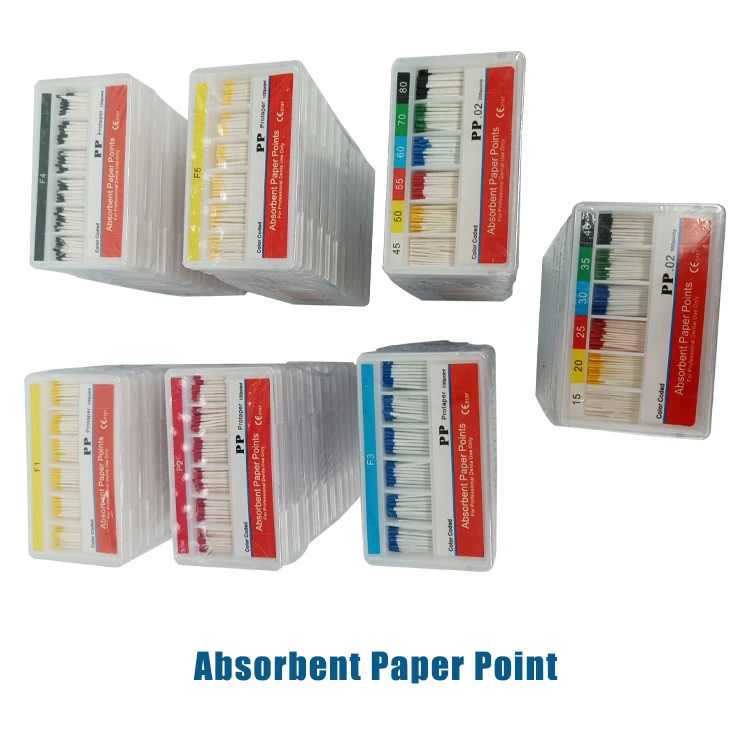
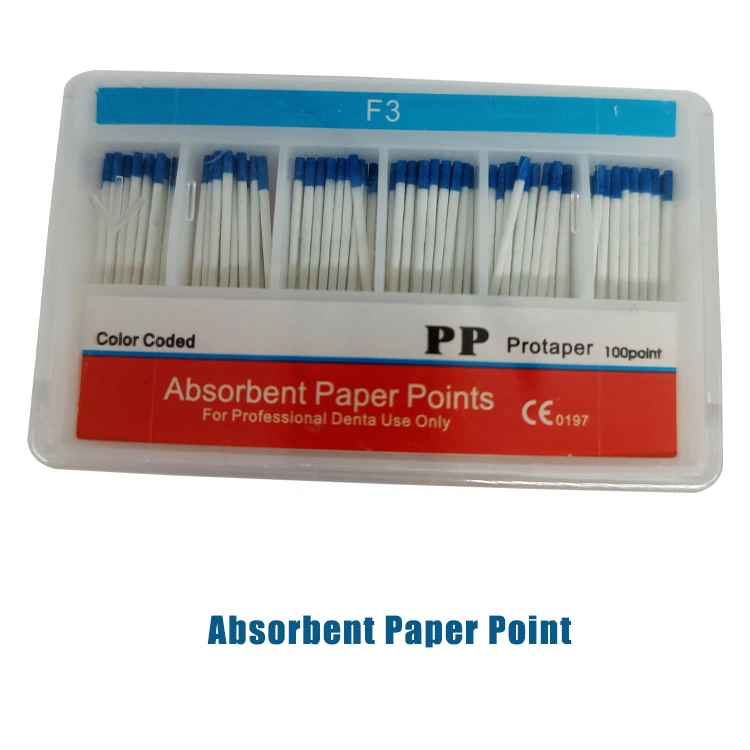
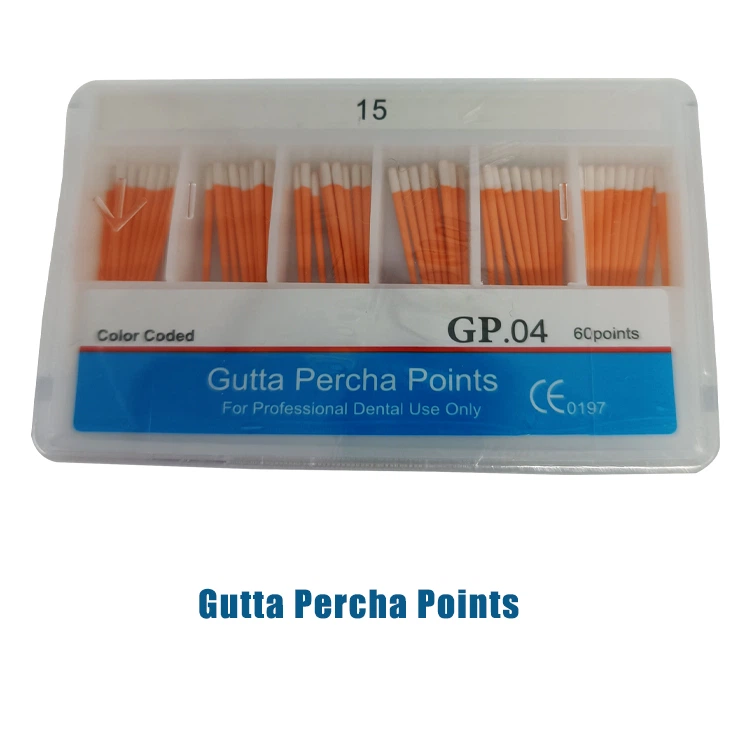
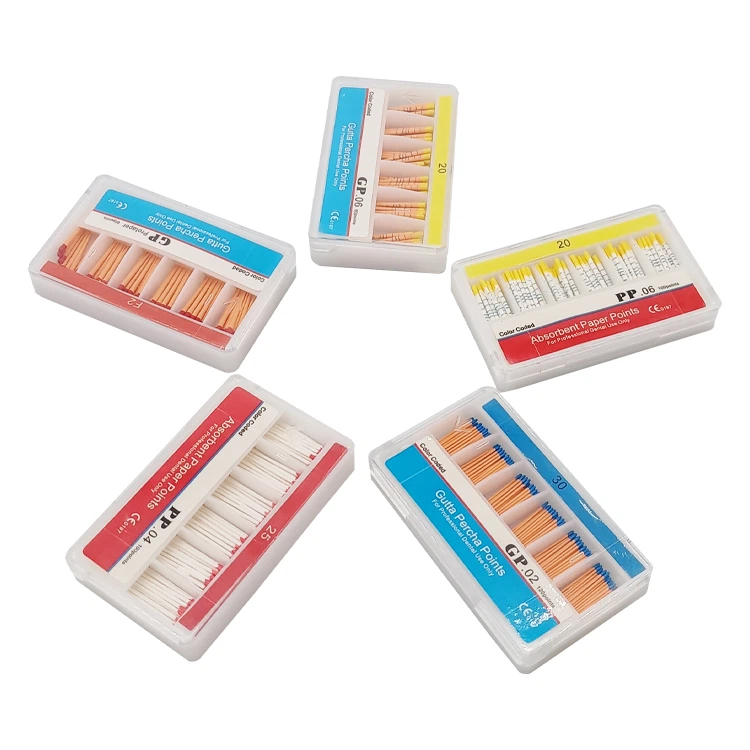
Gutta Percha Points
- Biocompatible: gutta percha points are non-toxic and can be safely used for root canal filling.
- Highly malleable: the gutta percha has thermoplastic properties and softens when heated, allowing it to more adapt to the complex morphology of the root canal.
- X-ray blocking: the gutta percha points of the adhesive is clearly visible under X-ray, which makes it easy for the doctor to confirm the filling effect.
- Dimensional stability: gutta percha points no significant shrinkage after filling, thus guaranteeing sealability
Description
Gutta percha points are a dental endodontic treatment of special solid root canal filling material, adapted to a variety of pulpitis, pulp necrosis, necrosis caries, all kinds of periapical inflammation in order to save the pulp through the living pulp preservation treatment failure of the teeth root canals, the permanent filling after the pulp.
Gutta percha points are usually small tapered flexible cones with gutta-percha, zinc oxide, barium sulfate, and toughening agents as the main ingredients. According to ISO standards, different models of Gutta percha points are identified according to the color of the top. It is characterized by plasticity, X-ray blocking, and easy confirmation of filling effect, and can be easily filled into the root tip of the tooth.
Gutta Percha Points Features
- Suitable for temporary obturation of root canals
- Good thermal shear effect
- Flexible and compact
- With or without scale
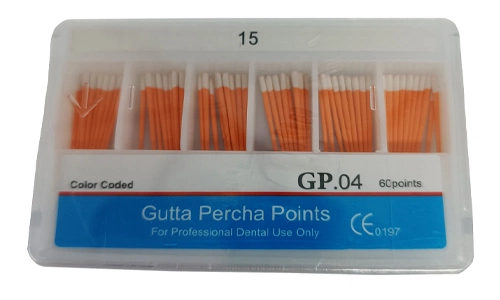
| Taper | Size |
| GD-3102 02 taper | (15#-40#)(45#-80#) mixed |
| GD-3104 04 taper | (15#-40#)(45#-60#) |
| GD-3106 06 taper | (15#-45#)(45#-60#) |
| GD-31F F series |
- It flows well after heating
- The clinical imaging shown are obvious
- Biocompatible
- With or without scale
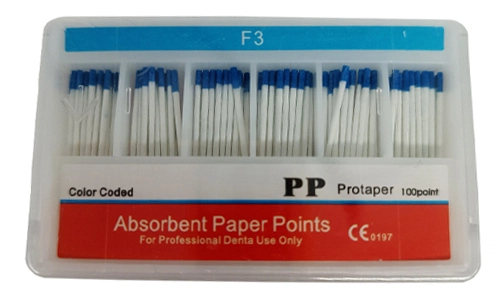
| Taper | Size |
| GD-3102 02 taper | (15#-40#)(45#-80#) mixed |
| GD-3104 04 taper | (15#-40#) |
| GD-3106 06 taper | (15#-40#) |
| GD-33F F series |
Due to their excellent biocompatibility and physical properties, gutta percha points have become one of the preferred materials for filling root canals.
Dental Screw Posts
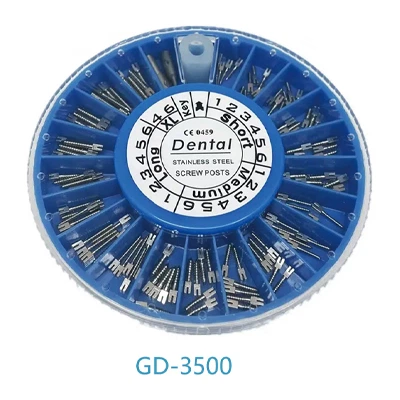
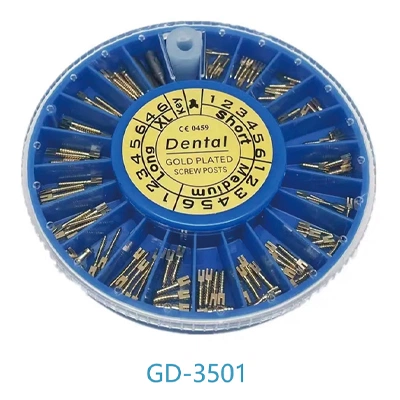
The Function of Gutta-Percha Points
As mentioned earlier, gutta-percha points are made from gutta-percha, zinc oxide, barium sulfate, and plasticizers. They exhibit excellent biocompatibility and X-ray opacity. These properties make gutta-percha points one of the preferred materials for root canal filling. How do they work in root canal filling?
During root canal filling, the main gutta-percha points provide the primary support, while finer gutta-percha points assist in support. Root canal sealer (typically epoxy resin) is then filled into the canal. The combination of these elements completely seals the root canal, preventing bacterial and viral invasion. This is the function of gutta-percha points in root canal filling. This is akin to pouring cement for a column, where the main gutta-percha points act as the main reinforcing bars, the finer gutta-percha points as the auxiliary reinforcing bars, and the root canal sealer as the concrete. Once cured, it forms a sturdy column.
Properties of Gutta-percha Points
Gutta-percha points have a certain degree of compressibility, allowing them to be packed tightly. After pressure is removed, they gradually return to their original shape. They also possess biocompatibility and X-ray opacity, and can be easily removed when necessary. However, dental gutta-percha tips lack elasticity and are difficult to insert into curved or lateral canals. Overfilling (using an inappropriate main gutta-percha tip that extends beyond the apical foramen) can irritate the periapical tissues.
When heated, dental gutta-percha tips soften, and after softening, they can be inserted into the root canal using a filling instrument, making it easier to access curved or lateral canals. However, improper heating or filling pressure can cause periodontal damage and increase the risk of overfilling.
Selection of The Main Gutta-percha Point
The taper of the main gutta-percha point should be equal to or slightly smaller than that of the main root canal file, with the same gauge as the main root canal file, and should provide a snug fit in the apical region within 1-3mm.
Example:
If the main file is 8% 25#, the preferred main gutta-percha point is 6% 25#. If it is too thick, choose 6% 20#; if it is too thin, choose 6% 30#. The appropriate standard for the main gutta-percha point is that there is a pulling sensation at the root canal apex, and even when applying appropriate force, the main gutta-percha point does not exceed the narrowed area.
If there is no tightening sensation in the apical region 1-3mm, the tip of the gutta-percha point should be gradually trimmed by 0.5mm until the appropriate length and tightening sensation are achieved. Then, an X-ray should be taken to assess the main gutta-percha point.
Note: Gutta-percha points should not be cut with scissors; instead, use a surgical knife. This is because the cross-section cut with scissors is flat, while the cross-section cut with a surgical knife is round.
The Position the Main Gutta-percha Point Should Reach
The standard for root canal filling is to reach the dentin-cementum junction, so it should not be determined solely based on the length shown on the X-ray. Instead, it should be combined with the measurement results from the root canal measuring instrument.
Detailed Steps for Using Gutta-percha Points
Preoperative preparation:
Accurately assess the root canal morphology, length, and curvature via X-ray, and select a main gutta-percha point that matches the main file type and taper. Refer to the previous section (selection of the main gutta-percha point) for specific methods. Pay special attention to mismatched gutta-percha points, which can cause overfilling or underfilling (the main gutta-percha point is too short to reach the apical foramen). This can lead to root canal treatment failure, and if not detected promptly, may result in root canal wall infection, periodontitis, gingivitis, and other issues. Ultimately, the repaired crown must be reopened, disinfected, and refilled.
Gutta-percha tip disinfection and sterilization:
After thorough cleaning and sterilization of the root canal, the gutta-percha points to be filled must also be thoroughly disinfected and sterilized. The gutta-percha points can be disinfected in a 2.5% sodium hypochlorite solution, and sterilization standards are typically achieved after 3 minutes. Before filling, use an air gun to dry them, do not use cotton balls or gauze to dry them.
Insertion procedure:
Gently and slowly insert the gutta-percha points to the desired length, ensuring the tip is tightly sealed with the apical foramen, do not force insertion if resistance is encountered, instead, replace or adjust the length of the gutta-percha points.
Filling method:
Use root canal sealer to enhance sealing, and compact the gutta-percha point using lateral or vertical compression techniques. Use auxiliary gutta-percha points to fill gaps. When heating the gutta-percha point to access curved or lateral canals, avoid prolonged exposure to heat sources to prevent burns to oral tissues or periodontal ligaments. Control force to prevent overfilling.
Verification of results:
After completing the gutta-percha point filling, use an X-ray to confirm the filling length, position, and density. If inadequate filling (overfilling or underfilling) is detected, the procedure must be repeated.
Once the above steps are successfully completed, the gutta-percha point portion is finished, and subsequent steps of root canal treatment can proceed.
FAQs
Gutta-percha point is a type of dental filling material primarily used for filling root canals during root canal treatment. It has excellent biocompatibility and X-ray opacity. Gutta-percha points can be used in conjunction with root canal sealing agents to completely seal the root canal after pulp removal, preventing bacterial invasion and reinfection.
During the initial phase of root canal filling, the filling material may irritate the surrounding dental tissues, causing mild pain and discomfort in some patients. This discomfort typically subsides within a week. During this period, strict oral hygiene must be maintained, which may help alleviate the pain more quickly.
- Root fracture: Excessive force during the insertion of the gutta-percha point may cause the root to fracture. Seek medical attention promptly.
- Periodontitis or gingivitis: Improper selection of the gutta-percha point may lead to overfilling or underfilling, resulting in incomplete sealing of the root canal. Bacterial proliferation may then cause inflammation and pain. Promptly eliminate the inflammation and perform a re-filling of the root canal.
Under normal circumstances, if root canal treatment is successful with no discomfort or inflammation, the gutta-percha point will remain sealed within the root canal and does not need to be removed. Removal is only necessary if root canal treatment fails, the gutta-percha point overfills and breaks through the apical foramen, causing severe pain or infection. In such cases, the gutta-percha point must be removed and root canal treatment repeated.
First, choose a reputable hospital with highly skilled professionals to perform the root canal treatment. If the procedure is successful, there should be no pain.
Second, maintain good oral hygiene. After root canal treatment, the tooth becomes relatively vulnerable due to the loss of pulp nutrition. Establish good oral hygiene habits to reduce bacterial growth and lower the risk of infection.
Finally, schedule regular dental check-ups to detect and address issues early. This approach can effectively prevent tooth pain.

